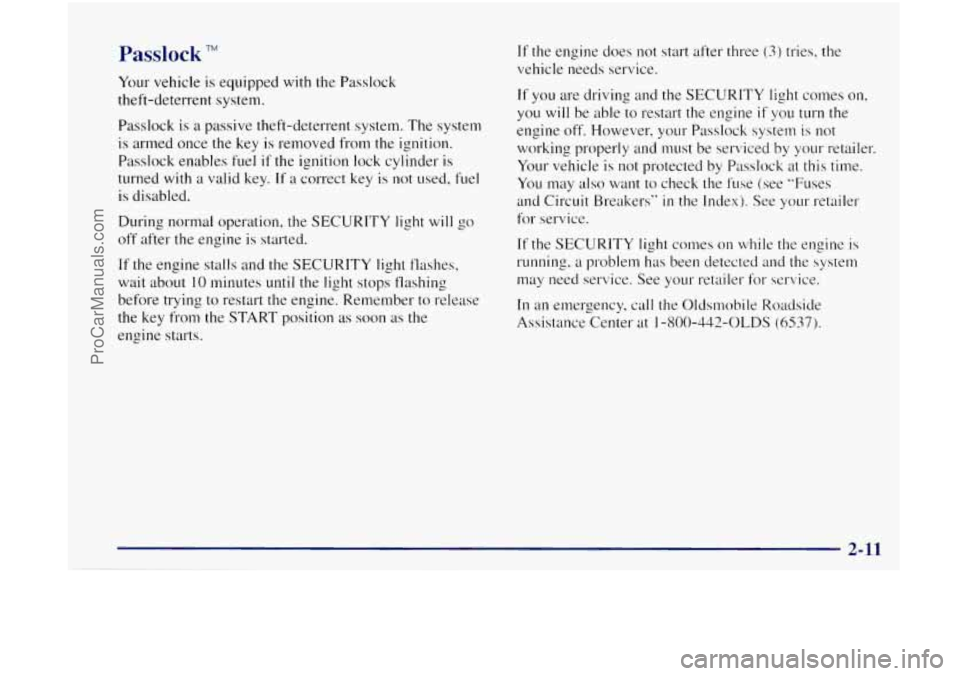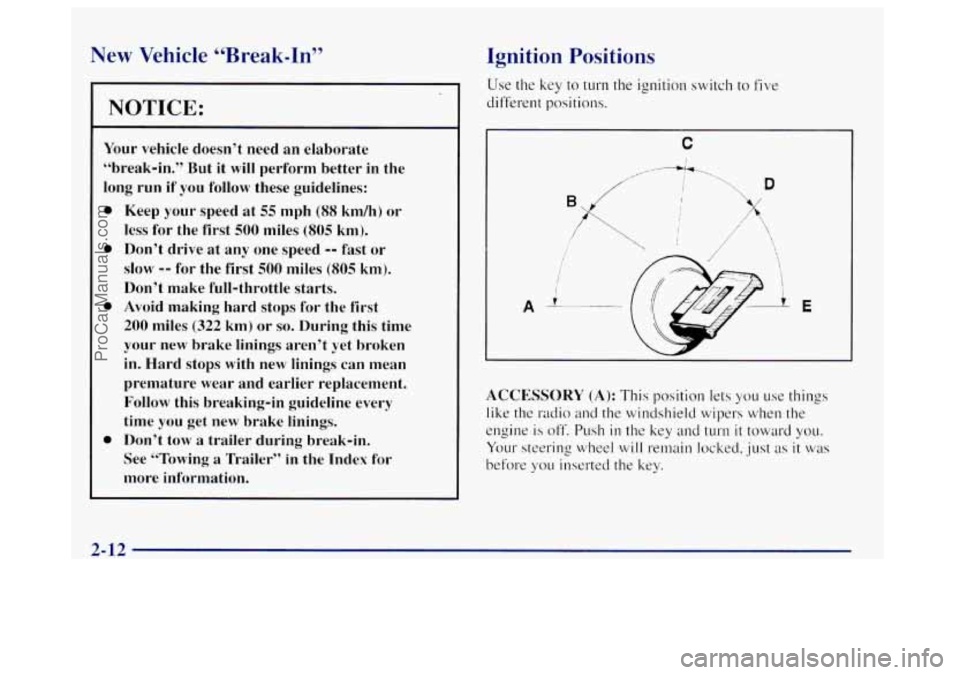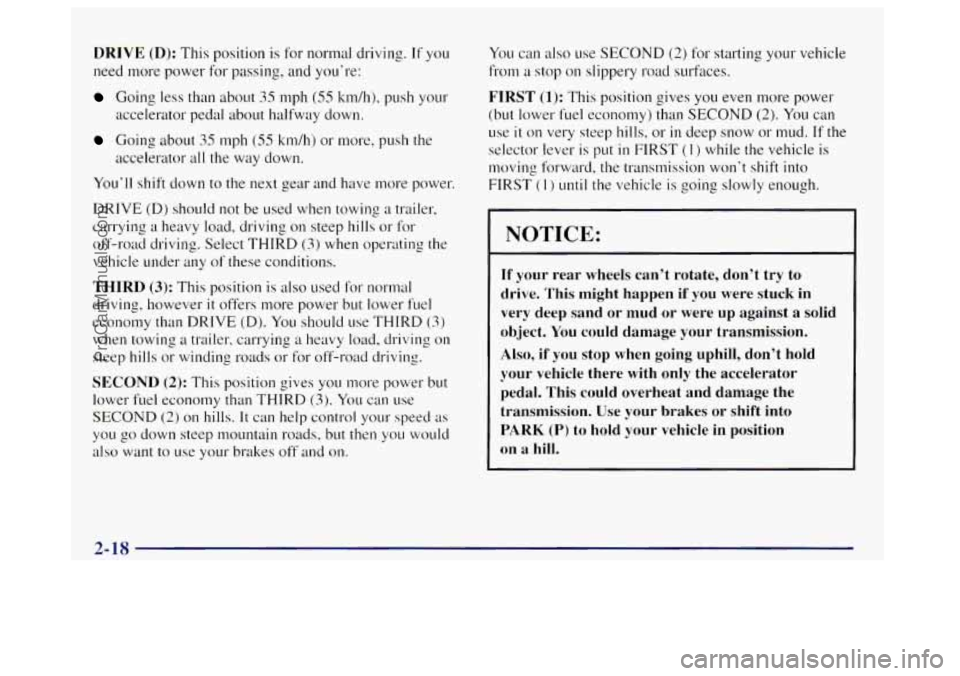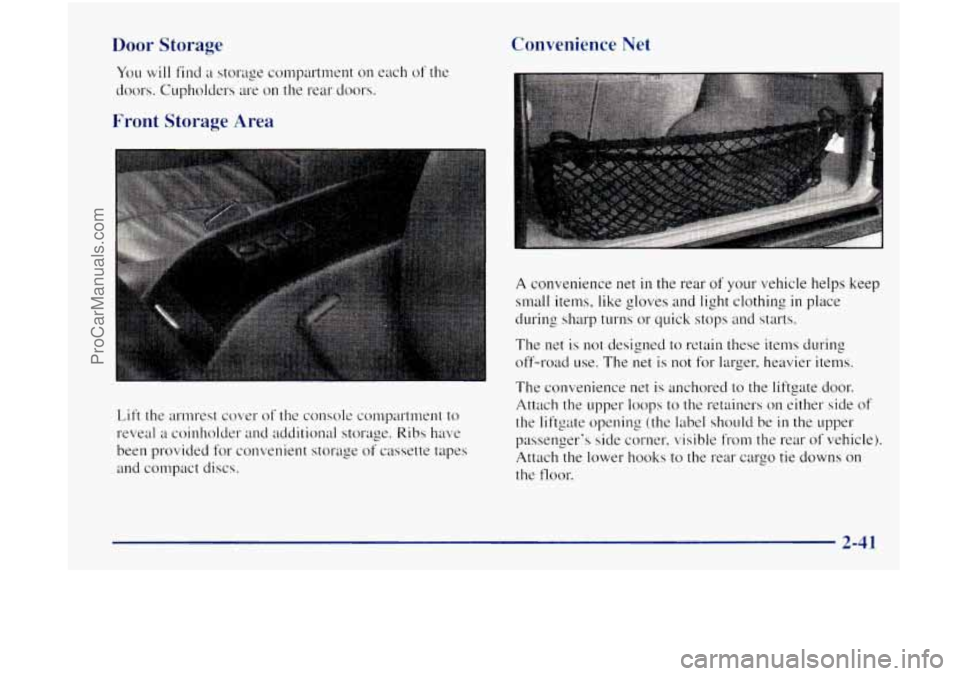stop start OLDSMOBILE BRAVADA 1998 Owners Manual
[x] Cancel search | Manufacturer: OLDSMOBILE, Model Year: 1998, Model line: BRAVADA, Model: OLDSMOBILE BRAVADA 1998Pages: 380, PDF Size: 19.2 MB
Page 75 of 380

Passlock TM
Your vehicle is equipped with the Passlock
theft-deterrent system.
Passlock
is a passive theft-deterrent system. The system
is armed once the
key is removed from the ignition.
Passlock enables fuel if the ignition lock cylinder
is
turned with a valid key. If a correct key is not used, fuel
is disabled.
During normal operation, the SECURITY light will go
off after the engine is started.
If the engine stalls and the SECURITY light flashes,
wait about
10 minutes until the light stops flashing
before trying to restart the engine. Remember to release
the key from the START position
as soon as the
engine starts.
If the engine does not start after three (3) tries, the
vehicle needs service.
If you are driving and the SECURITY light comes on,
you will be able to restart the engine if you turn the
engine off. However, your Passlock system is not
working properly and must be serviced by your retailer.
Your vehicle is not protected by Passlock at this time.
You may
also want to check the fuse (see “Fuses
and Circuit Breakers” in the Index). See your retailer
for service.
If the SECURITY light comes on while the engine is
running, a problem has been detected and the system
may need service. See your retailer for service.
In an emergency, call the Oldsmobile Roadside
Assistance Center at
1 -800-442-OLDS (6537).
ProCarManuals.com
Page 76 of 380

New Vehicle “Break-In”
NOTICE:
Your vehicle doesn’t need an elaborate
“break-in.” But it
will perform better in the
long run if you follow these guidelines:
a
0
a
0
Keep your speed at 55 mph (88 knlhj or
less for the first
500 miles (805 kmj.
Don’t drive at any
one speed -- fast or
slow
-- for the first 500 miles (805 km).
Don’t make full-throttle starts.
Avoid making hard stops for the first
200 miles (322 km) or so. During this time
your new brake linings aren’t yet broken
in. Hard stops with new linings can mean
premature wear and earlier replacement. Follow this breaking-in guideline every
time you get new brake linings.
Don’t tow
a trailer during break-in.
See “Towing a Trailer” in the Index for
more information.
Ignition Positions
Use the key to turn the ignition switch to five
different positions.
C
E
ACCESSORY (A): This position lets you use things
like the radio and
the windshield wipers when the
engine is off. Push in the key and turn it toward you.
Your steering wheel will remain locked, just
as it was
before
yo~l inserted the key.
2-12
- . -~
ProCarManuals.com
Page 78 of 380

Starting Your Engine
Move your shift lever to PARK (P) or NEUTRAL (N).
Your engine won’t start in any other position -- that‘s a
safety feature. To restart when you’re already moving,
use NEUTRAL
(N) only.
NOTICE:
Don’t try to shift to PARK (P) if your vehicle is
moving. If you do, you could damage the
transmission. Shift to PARK
(P) only when your
vehicle is stopped.
1. Without pushing the accelerator pedal. turn your
ignition key to START. When the engine starts. let
engine gets warm.
2 *o of the key. The idle speed will go down as your
NOTICE:
Holding your key in START for longer than 15
seconds at a time will cause your battery to be
drained much sooner. And the excessive heat can
damage your starter motor.
2. If it doesn’t start right away, hold your key in
START. If it doesn’t start in 10 seconds, push the
accelerator pedal all the way down for five more
seconds, or
until it starts.
3. If your engine still won’t start (or starts but then
stops), wait
15 seconds and start over.
When the engine starts, let
go of the key and the
accelerator pedal.
NOTICE:
Your engine is designed to work with the
electronics
in your vehicle. If you add electrical
parts or accessories, you could change the
way
the engine operates. Before adding electrical
equipment, check with your retailer. If you don’t,
your engine might not perform properly.
If you ever have to have your vehicle towed, see
the part of’this manual that tells how to
do it
without damaging your vehicle. See “Towing
Your Vehicle” in the Index.
2-14
ProCarManuals.com
Page 81 of 380

EIISLW the shift lever is f~~lly in PARK (P) range
before starting the engine. Your vehicle has
a
Brake-Transmission Shift Interlock (BTSI). You
have to fully apply your regular brakes before you can
shift from PARK
(P) when the ignition key is in RUN.
If you cannot shift out of PARK (P), ease pressure on
the shift lever -- press the button on the shift lever and
push the shift lever
all the way into PARK (P) as you
maintain brake application. Then move the shift lever
into the gear you wish. See ”Shifting Out of PARK (P)”
in the Index.
REVERSE (R): Use this gear to back up.
NOTICE:
Shifting to REVERSE (R) while your vehicle is
moving forward could damage your
transmission. Shift
to REVERSE (R) only after
your vehicle
is stopped.
To rock your vehicle back and forth to get out of snow,
ice or sand without damaging your transmission, see
”Stuck:
In Sand, Mud, Ice or Snow’‘ in the Index.
NEUTRAL (N): In this position, your engine doesn’t
connect
with the wheels. To restart when you’re already
moving, use NEUTRAL (N) only.
Shifting out
of PARK (P) or NEUTRAL (N) while
your engine
is “racing” (running at high speed) is
dangerous. Unless your foot
is firmly on the
brake pedal, your vehicle could move very
rapidly. You could lose control and hit people or
objects. Don’t shift out of
PARK (P) or
NEUTRAL (N) while your engine is racing.
I NOTICE:
Damage to your transmission caused by shifting
out of
PARK (P) or NEUTRAL (N) with the
engine racing isn’t covered by your warranty.
ProCarManuals.com
Page 82 of 380

DRIVE (D): This position is for normal driving. If you
need more power for passing, and you’re:
Going less than about 35 mph (5.5 km/h), push your
accelerator pedal about halfway down.
Going about 3.5 mph (5.5 km/h) or more, push the
accelerator all the way down.
You’ll shift down to
the next gear and have more power.
DRIVE (D) should not be used when towing
a trailer,
carrying a heavy load, driving on steep hills or for
off-road driving. Select THIRD
(3) when operating the
vehicle under any of these conditions.
THIRD (3): This position is also used for nornlal
driving, however
it offers more power but lower fuel
economy than DRIVE (D). You should use THIRD
(3)
when towing a trailer, carrying a heavy load, driving on
steep hills or winding roads or for off-road driving.
SECOND (2): This position gives you more power but
lower fuel economy than THIRD
(3). You can use
SECOND
(2) on hills. It can help control your speed as
you go down steep mountain roads, but then you would
also want to use your brakes off and on. You
can also use SECOND
(2) for starting your vehicle
from a stop
on slippery road surfaces.
FIRST (1): This position gives you even more power
(but lower fuel economy) than SECOND
(2). You can
use
it on very steep hills, or in deep snow or mud. If the
selector lever
is put in FIRST (I ) while the vehicle is
moving forward, the transmission won’t shift into
FIRST
(1) until the vehicle is going slowly enough.
-
NOTICE:
If your rear wheels can’t rotate, don’t try to
drive. This might happen if
you were stuck in
very deep sand or mud or were up against a solid
object.
You could damage your transmission.
Also, if you stop when going uphill, don’t hold
your vehicle there with only the accelerator
pedal. This could overheat and damage the
transmission. Use your brakes or shift into
PARK (P) to hold your vehicle in position
on a hill.
2-18
ProCarManuals.com
Page 92 of 380

Windshield Wipers
I-
You control the windshield wipers by turning the band
with
the wiper symbol on it.
For a single wiping cycle, turn the band to MIST. Hold
it there until the wipers start, then let go. The wipers will
stop after
one wipe. If you want more wipes, hold the
band
on MIST longer.
rcm
can set the wiper speed for a long or short delay
between wipes. This can be very useful
in light rain or
snow. Turn the band
to choose the delay time. The
closer
to LO, the shorter the delay. For steady
wiping at
low speed, turn the band away
from
you to LO. For high-speed wiping, turn the
band further, to HI. To stop the wipers, rnove the
band
to OFF.
Be sure to clear ice and snow from the wiper blades
before using them.
If they’re frozen to the windshield,
carefully loosen
or thaw them. IF your blades do become
worn
or damaged, get new blades or blade inserts.
Windshield Washer
There‘s a paddle marked with the windshield washer
symbol
on the top of the rnultifunction lever. To spray
washer fluid
on the windshield, push the paddle. The
wipers
will clear the window and then either stop or
return to your preset speed.
In freezing weather, don’t use your washer until
the windshield
is warmed. Otherwise the washer
fluid can form ice on the windshield, blocking
your vision.
2-28
-
ProCarManuals.com
Page 105 of 380

Door Storage
You will find a storage con1partment on each of the
doors. Cupholders are
on the rear doors.
Convenience Net
Front Storage Area
Lift the armrest cover of the console compartment to
reveal
a coinholder and additional storage. Ribs have
been provided for convenient storage of cassette tapes
and compact discs.
A convenience net in the rear of your vehicle helps keep
sinal1 items, like gloves and light clothing
in place
during sharp turns or quick stops and starts.
The net
is not designed to retain these items during
off-road use. The net is not for larger, heavier items.
The convenience net
is anchored to the liftgate door.
Attach the upper loops to the retainers on either side
of
the liftgate opening (the label should be in the upper
passenger’s side corner, visible from the rear of vehicle).
Attach the lower hooks to the rear cargo tie downs on
the
floor.
2-41
ProCarManuals.com
Page 111 of 380

The transmitter will learn and transmit the frequencies
of most current transmitters and is powered by your
vehicle’s battery and charging system.
This device complies
with Pcxt 15 of the FCC Rules.
Operation is subject
to the following two conditions:
( I ) this device may not cause Ilarn~ful interference,
and
(2) this device rnust accept any interference received,
including interference that may cause undesired operation.
This device complies
with RSS-210 of Industry Canada.
Operation is subject to the following two conditions:
( 1) this device may not cause interference, and (2) this
device rnust accept any interference, including interference
that may cause undesired operation of the device.
Changes and modifications
to this system by other than
an authorized service facility could void authorization to
use this equipment.
Programming the Transmitter
Do not use the rransrnitter with any garage door opener
that does not have the “stop and reverse” feature. This
includes any garage door opener mode1 manufactured
before April
1. 1982.
Be s1.1~ thcrt people cmcl ol?jec.t.s u1-e dcwr ofthe g~[r~rge
cloor ~vrt (o-e /7t.oSI.Clrlllllirlg!
Your vehicle’s engine should be turned off while
programming the transmitter. Follow these steps to
program
up to three channels:
1. If you have not previously programmed a universal
channel, proceed to Step
2. Otherwise, hold down
the two outside buttons on the universal transmitter
~~ntil the red light begins to flash rapidly
(approximately 20 seconds). Then release the
buttons. This procedure initializes the memory and
erases any previous settings for all three channels.
2. Hold the end of the hand-held transmitter against the
bottom surface of the universal transmitter
so that
YOLI can still see the red light.
3. Decide which one of the three channels you want to
program. Using both hands, press the hand-held
transmitter button and the desired button on the
universal transmitter. Contin~le
to hold both buttons
through Step
4.
4. Hold down both buttons until you see the red light
on the ~~niversal transmitter flash rapidly. The rapid
flashing, which could take
LIP to 90 seconds,
indicates that the universal transmitter
has been
programmed. Release both buttons once the light
starts to flash rapidly.
2-47
ProCarManuals.com
Page 121 of 380

Anti-Lock Brake System Warning Light
~ With the anti-lock brake
system, this light will
come on when you start
your e.ngine and may stay
on
for several seconds.
That’s normal.
If the light stays on, or comes on when you’re driving,
your vehicle needs service.
If the regular brake system
warning light
isn’t on, you still have brakes, but you
don’t have anti-lock brakes.
If the regular brake system
warning light
is also on, you don’t have anti-lock brakes
and there’s
a problem with your regular brakes. See
“Brake System Warning Light“ earlier
in this section.
The anti-lock brake system warning light should come
on briefly when you
turn the ignition key to RUN. If the
light doesn’t come on
then, have it fixed so it will be
ready to warn you
if there is a problem.
Engine Coolant Temperature Gage
This gage shows the
engine coolant temperature.
If the gage pointer moves
into the red area. your
engine is too hot!
It means that your engine coolant has overheated. If you
have been operating your vehicle under normal driving
conditions, you should pull
off the road. stop your
vehicle and
turn off the engine as soon as possible.
In “Problems on the Road,“ this manuill shows you what
to do. See “Engine Overheating”
in the Index.
2-57
ProCarManuals.com
Page 123 of 380

If the Light Is Flashing
The following may prevent more serious damage to
your vehicle:
0 Reducing vehicle speed.
0 Avoiding hard accelerations.
0 Avoiding steep uphill grades.
0 If you are towing a trailer, reduce the amount of
cargo being hauled
as soon as it is possible.
If the light
stops flashing and remains on steady, see "If
the Light
Is On Steady'. following.
If the light continues to flash, when it is safe to clo so,
stop the vel?icle. Find a safe place to park your vehicle.
Turn the key off, wait at least 10 seconds and restart the
engine.
If the light remains on steady, see "If the Light
Is On Steady" following. If the light is still .flashing,
follow the previous steps, and drive the vehicle to your
retailer or qualified service center for service.
If the Light Is On Steady
YOLI may be able to correct the emission system
malfunction by considering
the following:
Did you recently
put fuel into your vehicle'?
If so, reinstall the fuel cap, making sure to fully install
the cap. The diagnostic system can determine
if the fuel cap
has been left off or improperly installed.
A loose or
missing fuel cap
will allow fuel to evaporate into the
atmosphere.
A few driving trips with the cap properly
installed should turn the light off.
Did you just drive through a deep puddle
of water?
If so, your electrical system may be wet. The condition
will usually be corrected when the electrical system
dries out. A few driving trips should
turn the light off.
Have you recently changed brands
of fuel?
If so, be s~~re to file1 your vehicle with quality fuel (see
"Fuel"
in the Index). Poor fuel quality will cause your
engine not
to run as efficiently as designed. You may
notice
this as stalling after start-up, stalling when you put
the vehicle into gear, misfiring, hesitation on acceleration
or stumbling on acceleration. (These conditions may go
away once the engine is warmed up.) This
will be detected
by the system and cause the light to turn
on.
If YOLI experience one or more of these conditions,
change the fuel brand
yo^^ use. It will require at least one
full tank of the proper fuel to turn the light off.
If none of the above steps have made the light turn off,
have your retailer or qualified service center check the
vehicle. Your retailer has the proper test equipment and
diagnostic tools
to fix any mechanical or electrical
problems that may have developed.
ProCarManuals.com